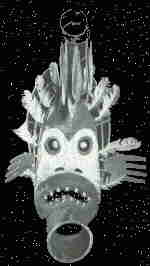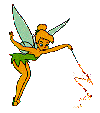 A wooden dance mask representing Negafok the cold-weather spirit. Museum of the American Indian, Heye Foundation, New York. |
The Inuit people are the Arctic nomads which we commonly refer to as "The Eskimo". The title seems to be derived from Algonquin meaning "raw flesh eater." Not surprising then these people prefer to call them selves Inuit which means simply "men." Unlike most other native American cultures, the Inuit do not hold common belief about the gods or the origin of man. The do not have a belief system that is based on life in great forests or do they hold spirits that deal with the efforts to bring forth crops. A study of their culture is really based upon the hardship of existence in an environment that is as hostile and unforgiving as the arctic north. The images in the Inuit existence dealt with the observation he had, the movement of animals (elk) or birds as they migrated south. The seasons precipitate by months of sunshine or darkness, or the aurora borealis in which the ancestors could be seen to dance. The tales very between the groups but one tale which seems to be present through out the Inuit is that of "The old woman who lives under the sea." |
The old woman who lives under the sea carries many different names depending upon where you are. She is known as Nerivik in Alaska, or Arnarquagssag in greeland and Sedna in between. She is fill the role of "The Great Earth Mother" that is almost universal.
The story goes that there were a giant couple in the earth and that they had a child, a girl. She grew rapidly and was horrifically inclined to eat flesh, in huge qualities as she was always hungry. It follows that one night her parent awoke to find her eating the flesh from their legs. They could not tolerate that so they took her to sea in a great umiak(skin covered boat) and there cut off her fingers. As her fingers fell into the ocean they change and became whales and seals and great shoals of fish. The giants were most frightened and cast her into the sea and returned home. There they lived long so the story is told and died by freezing to death many years later.
This (giant) demon girl that lived under the sea, became Sedna, mother of all the sea creatures. It is Sedna who has control of all the weather at sea, bring storms as she will. She also controls the migration of her children. For the Inuit, there was no time before and they don't perceive of Sedna being a change in the world. She was approachable through the efforts of the Shaman. The Shaman would go into a trance and his spirit would travel to see her, where after some time she would advise him on the nature of things to come. From that information, the tribes would act, to stay and wait for things to change (food to return) or to move again in search of more fertile grounds.
The Spirit World
